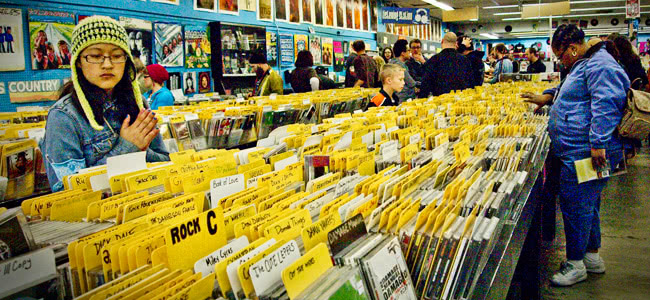It seems that reports about the death of the album format aren’t so exaggerated after all.
Album sales have hit an all-time low in the US where, at the end of July, they fell under the average 5 million mark for five consecutive weeks. Which marks the longest stretch of poor album sales since Neilsen SoundScan began tracking them in May 1991, as Billboard reports.
The sales data shows that for the week ending 28th July, American album sales reached 4.68 million, a new low with the previous bottom-out being the week prior at 4.71 million units. Half-year sales – including CDs, vinyl, digital albums – are also down 5.6% to 142 million units.
There are a number of reasons for the significant dip in album sales, with music industry reports citing the steadily declining drop in CD sales, a disinterest in back catalogue, and competition from other entertainment media as being contributing factors.
While album sales are at a historic low, revenue from music streaming services, like Spotify, Deezer, and Pandora, is still growing – even taking a significant bite out of Apple’s iTunes as more users shift to cheaper, accessible models. Which begs the question of whether they are also cannibalising traditional sales of records. Album sales reached 4.68 million, a new low with the previous bottom-out being the week prior at 4.71 million units.
The success of opening sales from Justin Timberlake’s The 20/20 Experience and Daft Punk’s Random Access Memories (the biggest selling vinyl release of the year so far) would suggest otherwise, as Spotify’s own CEO Daniel Ek defended. While Mumford & Sons’ sophomore release Babel – which sold 600,000 copies in its firs week while racking up 8 million streams – has been used as example of how free streaming model may in fact be contributing to physical sales and paid digital downloads.
The head of Mumford & Sons’ independent label Glassnote Records, Daniel Glass, agrees saying that the all-time low album sales figures shows “we’re in a transition;” telling Rolling Stone: “Streaming is up. The economic model is not there today, but it will be there… Our business is up. Ticket sales are great. Our groups are thriving. We can’t afford to have a dying model.”
Love Music?
Get your daily dose of metal, rock, indie, pop, and everything else in between.
However, former Island Def Jam Records president Jim Caparro disagrees, telling the US magazine that “the idea of unlimited access to everything for one fee a month is a very attractive proposition” to consumers and drawing them away from digital sales platforms like iTunes and Amzon. “The record companies have to re-engineer themselves [around music streaming services] to continue to be relevant and profitable.”
While the debate surrounding the boom of music streaming services as being a good or bad thing for the industry, an argument that gained new attention through the spat between Atoms For Peace and Spotify and artists continuing to criticise the likes of Pandora for their low royalty rates, the irony of the historic low in album sales is that the bastion of the format – vinyl – is in as healthy a state as its been for a long time.
In America, a mid-year report from Nielsen Soundscan estimated that 2.9 million vinyl LPs have been sold in the first half of 2013, showing a 33% increase for the same period in 2012. The IFPI’s end-of-year report showed that vinyl sales totalled 12 million in 2012, four times as many as those sold in 2006.
While over in the UK, vinyl sales have helped independent record stores get their groove back, experiencing a 44% boost in sales in the first six months of 2013 compared to the same period last year. The results come from the the Entertainment Retailers Association (ERA), which shows that 50% of all vinyl LP sales in Britain come from independent stores, demonstrating that while vinyl only accounts for 3.2% of all album sales, they are buoying indie retailers against competition from bigger music retailers, digital services, and online piracy – helped in large part by the success of this year’s Record Store Day.
The question remains whether the worrying drop in album sales is the start of a downward trend or an isolated blip in a much larger pattern as the music industry makes the inevitable shift to digital.

































